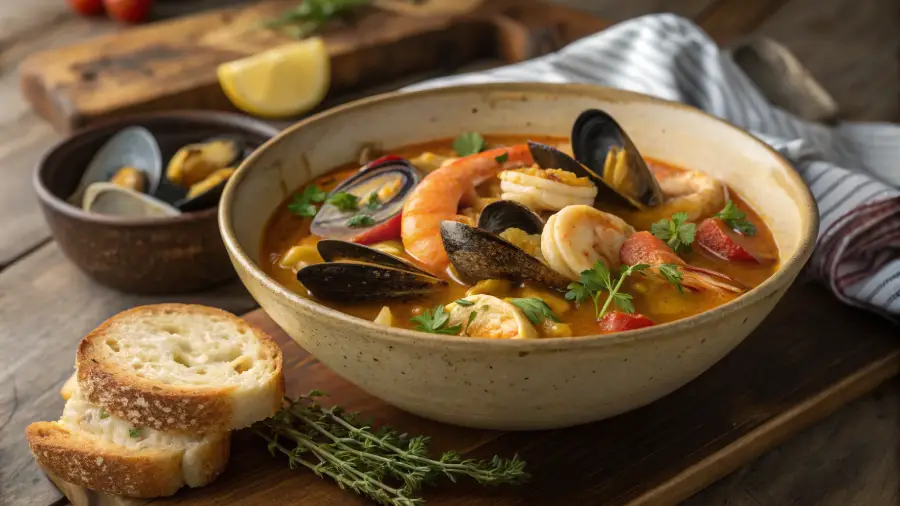Bouillabaisse
Description :
Bouillabaisse is a rich, flavorful French fish stew originating from the port city of Marseille in Provence. Traditionally, it’s made with various kinds of fish, shellfish, and sometimes other seafood like squid, combined with vegetables, herbs, and aromatic spices. The key to this dish is the variety of fish, typically including local Mediterranean varieties such as rascasse, red mullet, and conger eel. It’s often served with a side of rouille, a garlicky, saffron-infused mayonnaise-like sauce that enhances the flavor. Bouillabaisse is enjoyed as a comforting meal, particularly during colder months.
Ingredients (for 4 servings):
- 1 lb (450g) white fish fillets (like cod or bass)
- 1 lb (450g) shellfish (mussels, clams, or prawns)
- 1 onion, chopped
- 2 tomatoes, diced
- 1 leek, sliced
- 1 fennel bulb, sliced
- 4 garlic cloves, minced
- 1 tsp saffron threads
- 1 tsp dried thyme
- 1 bay leaf
- 1/4 cup olive oil
- 6 cups fish stock
- Salt and pepper to taste
- 1/2 cup white wine
Calories: Approximately 350–400 calories per serving, depending on the type and amount of seafood used.
Cooking Instructions :
Bouillabaisse’s origins trace back to the humble fishermen of Marseille, who would combine leftover fish, often considered too small or tough to sell, with herbs and vegetables to create a hearty, nourishing meal. Over time, the dish evolved into a celebrated part of Provençal cuisine. Historically, the soup was prepared by simmering a variety of local fish with tomatoes, saffron, fennel, and other aromatic ingredients, a practice which elevated the broth into a beloved regional specialty.
To prepare bouillabaisse, heat olive oil in a large pot and sauté the onion, leek, fennel, and garlic until softened. Add the tomatoes and cook for another few minutes. Pour in the fish stock and white wine, followed by the saffron, thyme, and bay leaf. Bring the mixture to a boil, then reduce the heat and let it simmer for about 20 minutes to develop the flavors. Add the fish fillets and shellfish, cooking for an additional 10-12 minutes, until the seafood is tender and cooked through. Season with salt and pepper to taste.
Serve the bouillabaisse hot, with a dollop of rouille on the side. Traditionally, crusty baguette slices are also served to dip in the broth. This dish reflects the simplicity and elegance of Mediterranean flavors, capturing the essence of Provence in every bite.
History :
Bouillabaisse has a rich history rooted in the Mediterranean fishing culture, particularly in the port city of Marseille, France. The dish originally emerged as a practical, humble meal for fishermen. In the past, the freshest and most desirable fish were sold, while smaller, less marketable fish—such as rascasse (scorpion fish)—were left behind. These “discarded” fish were then combined with aromatic herbs and vegetables to create a hearty, flavorful stew. Over time, the stew became a staple for Marseille’s working-class fishermen, who cooked it on their boats or in simple kitchens, making the most of the local ingredients available to them.
The word « bouillabaisse » itself comes from the Provençal dialect, where « bouillabaisser » means « to boil and lower, » referring to the process of bringing the broth to a boil before reducing the heat to allow the flavors to meld. Initially, the dish was a practical way to use the catch of the day, but it eventually gained popularity, particularly with locals and travelers, due to its rich flavors and distinctive combination of fish and herbs.
By the 19th century, bouillabaisse became a symbol of the Mediterranean diet and was gradually elevated from a simple fishermen’s stew to a delicacy served in restaurants. It was adopted by the French bourgeoisie and became a celebrated dish of Provençal cuisine. In the modern era, bouillabaisse is a cherished dish in Marseille and across Provence, served in a variety of forms but always celebrating the region’s bountiful seafood and rich culinary traditions.





